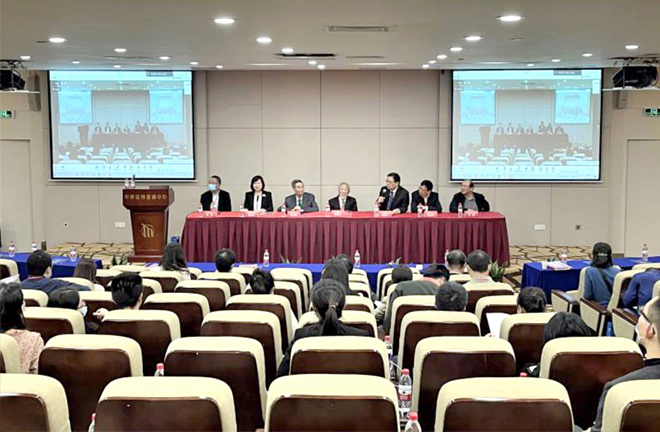Seminar probes aesthetics with Chinese features

A symposium on building the theoretical system and discourse system of Chinese aesthetics on Nov. 13 and 14 Photo: Li Yongjie/CSST
In mid-November, the 9th National Aesthetics Conference of the Chinese Society for Aesthetics and the concurrent International Symposium on the Basic Issues of Aesthetics with Chinese Characteristics in the New Era were held in the main venue of Shenzhen and the branch venue of Beijing via video links. The participating scholars exchanged views on constructing the theoretical system and discourse system of Chinese aesthetics.
Forming Chinese features
At present, the context of aesthetic research has undergone profound changes, where the changes in lifestyle, the renewal of technical conditions, and the development of literature and art have all affected aesthetic research, which is aiming itself at constructing the disciplinary system, academic system, and discourse system of aesthetics with Chinese features, style, and ethos.
At the opening ceremony, Zhang Jiang, former vice president of the Chinese Academy of Social Sciences, briefly discussed some of his ideas on the construction of Chinese hermeneutics, adding that hermeneutics and aesthetics can be combined to deepen aesthetic research. Building a Chinese school of aesthetics should be rooted in the deep soil of refined traditional Chinese culture and reality, while strengthening dialogue with Western cultures.
Over the past two or three decades, new thoughts and new theories from abroad have been quickly introduced and accepted by domestic aesthetic circles. As exchanges and coordinated development with international aesthetics represent a huge advancement in contemporary Chinese aesthetics, it has also encountered new challenges about how to successfully integrate Chinese and Western aesthetics and promote the construction of aesthetics with Chinese characteristics.
Peng Lixun, former president of the Shenzhen Academy of Social Sciences, said that Chinese and Western aesthetics are two different cultural systems, theoretical systems, and discourse systems. To accomplish the smooth integration of Chinese and Western aesthetics, efforts must be made on the creative transformation of traditional Chinese aesthetics, which is to say, to explore its contemporary value and significance; new historical connotations should be defined within traditional aesthetic thoughts in accordance with the characteristics and requirements of the new era, while supplementing, expanding, and improving its content. Additionally, scholars are tasked with bridging the gap between Chinese and Western aesthetics in the cultural system, theoretical system, and discourse system, and achieving mutual integration through equal dialogue, so that the two can attain mutual understanding, learning, complementation, and blending.
The construction of aesthetic tastes is a natural requirement with the development of social life. In today’s China, aesthetics has ushered in a great momentum for development, due to the people’s pursuit of a tasteful life now that their living standards have improved markedly. In this process, aesthetics need to take on a critical role.
Gao Jianping, president of the Chinese Society for Aesthetics and a professor at Shenzhen University, suggested employing aesthetics to drive urban and rural construction, aid literature and art studies and literary criticism, and bring social development, while nourishing people’s souls and improving their aesthetic tastes through aesthetic education. These are the tasks that should be done in the field of aesthetics and also the historical mission that should be shouldered by contemporary aesthetic researchers.
Highlights from traditional aesthetics
In the view of Pan Liyong, a professor of philosophy from the School of Humanities at Zhejiang University, as “Neo-Confucianism aesthetics” has passed down the aesthetic tenet of Confucian aesthetics that regards “benevolence” as the theoretical foundation and purpose, it transcends the original Confucian vision of the “benevolence theory” and absorbs the ontological thoughts and speculative factors of Taoist aesthetics and Buddhist aesthetics. It owns an academic system with indigenous originality in terms of theoretical traits and discourse system, and entertains the theoretical form of Chinese classical philosophical aesthetics favoring ontologization, speculation, and systemization, most typically embodying the theoretical elements and discourse characteristics of Chinese aesthetics of xin xing [mind and heart and human nature].
In the theoretical construction and criticism practice of contemporary aesthetics, the thoughts on imagery in ancient China still contribute great value. Zhu Zhirong, a professor from the Department of Chinese Language and Literature at East China Normal University, noted that despite China and the West’s similarities and differences in interpreting “imagery,” the concept has applicability to generalizing the common aesthetic characteristics of China and the West, and has extensive application value in aesthetic practice, thus possessing the possibility of being accepted by Western scholars.
The modern philosopher Feng Youlan proposed the four realms of life: the natural realm, the utilitarian realm, the moral realm, and the realm of heaven and earth.
Wang Yichuan, a professor from the Research Center of Literature and Art at Beijing Normal University, commented that this appears to be a clear divergence from the hierarchy of needs theory proposed by American psychologist Abraham Maslow. This kind of interpretation of the realm of life, which places attention on the connection between individuals and society and the integration between human beings and heaven and earth, can avoid falling into the traps of extreme individualism and liberalism common in the West. It also lays a strong theoretical ground for the reconciliation and harmony between mankind and the natural environment and ecology, as well as for the promotion of environmental protection and ecological progress.
Chinese classical aesthetics is about the aesthetics of “category,” which serves as a backbone. Thus the top priority in the discipline rests on clarifying categories. When referring to activating the contemporary value of Chinese classical aesthetics, Li Jian, a professor from the Institute of Aesthetics and Literary Criticism at Shenzhen University, suggested closely following the development of literature and art and reinforcing the dialogue between classical Chinese aesthetics and Western aesthetics.
Edited by YANG LANLAN
